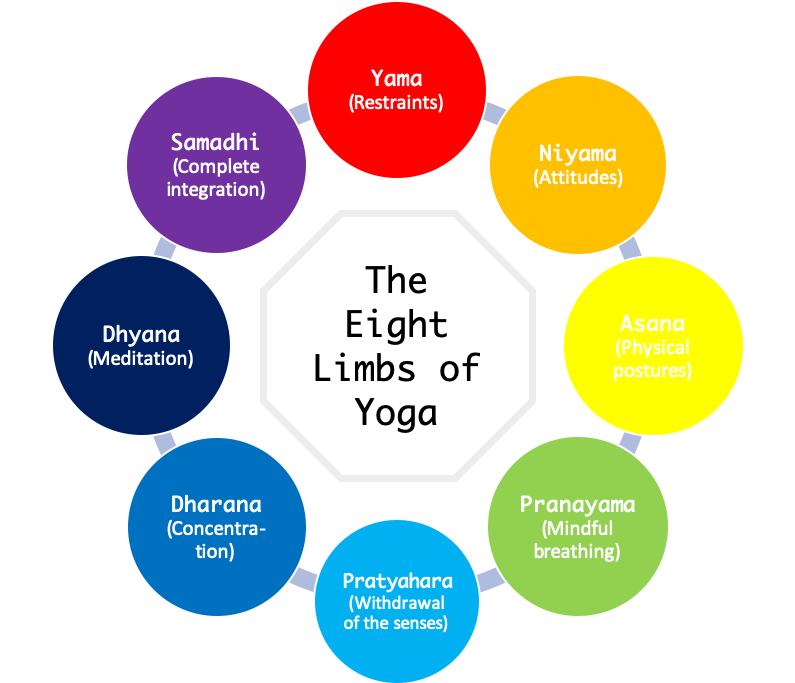So you thought yoga was all about the postures?

The Yoga Sutra’s of Patanjali are considered the ultimate yogic text. They are a collection of 196 Indian sutras (texts or manuals) complied by the Sage Patanjali outlining the theory and practice of yoga. In them Patanjali describes the eight-fold path, known as Ashtanga (ashta= eight, anga= limb), these 8 limbs outline a set of observances, practices and principles that yogis strive to live by, both on and off the mat. Their aim is to ensure you to live a purposeful and meaningful life and guide your spiritual journey.
______________________________________________________________________________
1. Yama – Attitudes towards our environment (Restraints)
According to Patanjali’s Yoga Sutra, the first step on the true path of yoga is Yama. The yamas are a set of abstentions or moral restrains and are concerned with our attitudes towards the environment. There are 5 yamas:
1. Ahimsa: Non-violence
Ahisma refers not only to physical violence, but the equally damaging consequences of our words and thoughts, both towards others and ourselves.
2. Satya: Truthfulness
Satya encompasses not only truthfulness, but integrity, so that not only do we act with the intention of being truthful to others, we are also truthful to ourselves.
3. Asteya: Non-stealing
Asteya is concerned with non-stealing, we are not to take what is not ours. It is also concerned with stealing from ourselvessuch as restricting our practice by a lack of commitment, wasting time or neglecting a talent.
4. Brahmacharya: Moderation
Brahmacharya translates to “walking with god”. It classically meant celibacy, not only to give up sex, but to transmute our sexual energy in the devotion to God. Clearly this does not fit with most modern yogis and todays definition could be understood to mean respecting ourselves and our partners by remaining faithful within a monogamous relationship, not using others, or having sex mindlessly.
5. Aparigraha: Non-covetousness
Aparigraha is concerned with letting go of the attachment. It is to be happy with what you have and to take only what you need, instead of coveting what others have with jealousy, envy, and greed.
______________________________________________________________________________
2. Niyama – Attitudes towards ourselves (Observances)
The second of the eight limbs is Niyama. The niyamas are ethical observances concerned with the yogis’ own personal discipline and practice. They can be considered inward practices to improve the self. There are 5 niyamas:
1. Saucha: Cleanliness
Saucha refers to internal and external cleanliness or purification of the body and mind. We are reminded to live healthy lives, keeping the body and mind pure.
2. Santosa: Contentment
Santosa encompasses the inherent happiness we feel when the mind is tranquil. It is concerned with a lack of desire for what others have. We can better learn to practice this by cultivating and expressing gratitude.
3. Tapas: Asceticism
Tapas is concerned with the voluntary control of the senses. In the context of spiritual practice, this requires austerity and self-discipline. In daily practice it may be achieved through postures and meditation. Tapas can also be translated as “heat”, it is often interpreted as practices which stoke the internal fire.
4. Svadhyaya: Study
Svadhyaya refers to the study of the sacred scriptures and also the repetition of Om or other devotional mantras. It can also be considered the study of oneself.
5. Isvara Pranidhana: Devotion to a higher power
Isvara Pranidhana is a devotion to a higher being or power. This does not necessarily mean to worship a god but instead to approach our practice in the spirit of offering and surrender.
______________________________________________________________________________
3. Asana – Physical postures
Originally meaning, seat, asanas are postures that prepare the yogis’ body to sit firmly (sthira) and comfortably (sukha) for long periods for the purposes of meditation and pranayama practices. Patanjali provides no instruction on how to perform asanas.
______________________________________________________________________________
4. Pranayama – Breath control
The regulation and slowing of the movement of the breath so that the mind may also become regulated and quiescent.
______________________________________________________________________________
5. Pratyahara – Withdrawal of the senses
The drawing of our awareness inwards. Sensory inputs such a sounds, sights and smells must be recognised as external stimuli, separate from our internal self, which we must not allow to capture our attention. This is a necessary step if we are to progress towards mediation and the practices described in the final three limbs. Pratyahara lays the foundation for dharana.
______________________________________________________________________________
6. Dharana – Concentration
Fixing the mind on an object of meditation, this point of focus can be a silent repetition of sound, an energetic centre or part of the body or an image in the mind’s eye. This stage precedes meditation and is considered to be the first step on the path towards freedom from suffering. Dharana prepares us for dhyana.
______________________________________________________________________________
7. Dhyana – Meditation
Dhyana is considered the continuous, uninterrupted flow of the mind without distraction from thoughts. Where dharana practices specific, focussed attention, dhyana is the state of being keenly aware without focus.
______________________________________________________________________________
8. Samadhi – Complete integration
Full meditative absorption otherwise considered the union of the self with the object of meditation. Patanjali subdivides samadhi into seven levels, the highest level (asamprajnata-samadhi) is the ultimate state of awareness in which nothing can be discerned but the pure self. This state of enlightened bliss is considered to be the ultimate goal of life.
______________________________________________________________________________